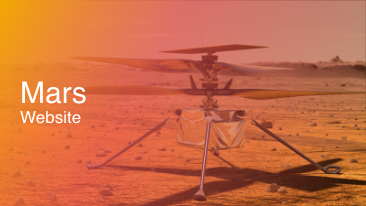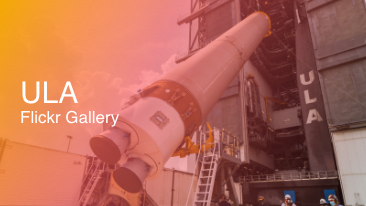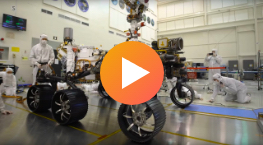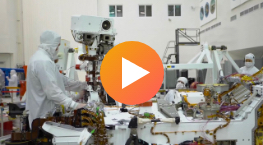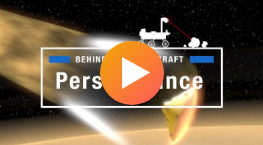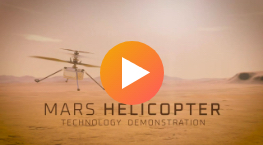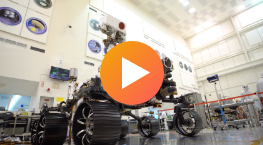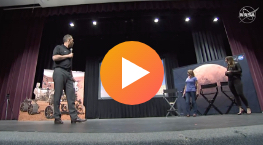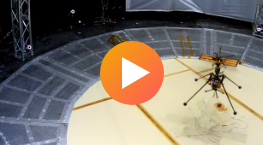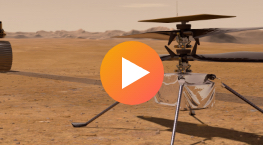Web Videos
Historical Mars Missions
In addition to NASA’s Mars 2020 Perseverance rover and the Ingenuity Mars Helicopter, humankind’s other missions to Mars are listed below. Each item includes mission name: country; launch date; purpose and results.
Marsnik 1: USSR; Oct. 10, 1960; flyby; did not reach Earth orbit
Marsnik 2: USSR; Oct. 14, 1960; flyby; did not reach Earth orbit
Sputnik 22: USSR; Oct. 24, 1962; flyby; achieved Earth orbit only
Mars 1: USSR; Nov. 1, 1962; flyby, radio failed at 65.9 million miles (106 million kilometers)
Sputnik 24: USSR; Nov. 4, 1962; flyby; achieved Earth orbit only
Mariner 3: U.S.; Nov. 5, 1964; flyby; shroud failed to jettison
Mariner 4: U.S.; Nov. 28, 1964; first successful flyby July 14, 1965; returned 21 photos
Zond 2: USSR; Nov. 30, 1964; flyby; passed Mars but radio failed, returned no planetary data
Mariner 6: U.S.; Feb. 24, 1969; flyby July 31, 1969; returned 75 photos
Mariner 7: U.S.; March 27, 1969; flyby Aug. 5, 1969; returned 126 photos
Mars 1969A: USSR; March 27, 1969; orbiter; did not reach Earth orbit
Mars 1969B: USSR; April 2, 1969; orbiter; failed during launch
Mariner 8: U.S.; May 8, 1971; orbiter; failed during launch
Kosmos 419: USSR; May 10, 1971; lander, achieved Earth orbit only
Mars 2: USSR; May 19, 1971; orbiter and lander; arrived Nov. 27, 1971; no useful data, lander burned up due to steep entry
Mars 3: USSR; May 28, 1971; orbiter and lander; arrived Dec. 3, 1971; lander operated on surface for 20 seconds before failing
Mariner 9: U.S.; May 30, 1971; orbiter; operated in orbit Nov. 13, 1971 to Oct. 27, 1972, returned 7,329 photos
Mars 4: USSR; July 21, 1973; orbiter; flew past Mars Feb. 10, 1974 and collected some data, but did not achieve Mars orbit
Mars 5: USSR; July 25, 1973; orbiter; arrived Feb. 12, 1974, lasted a few days
Mars 6: USSR; Aug. 5, 1973; flyby module and lander; arrived March 12, 1974, lander failed due to fast impact
Mars 7: USSR; Aug. 9, 1973; flyby module and lander; arrived March 9, 1974, lander missed the planet
Viking 1: U.S.; Aug. 20, 1975; orbiter and lander; entered orbit June 19, 1976, and operated until Aug. 7, 1980; landed July 20, 1976, and operated until Nov. 11, 1982
Viking 2: U.S.; Sept. 9, 1975; orbiter and lander; entered orbit Aug. 7, 1976, and operated until July 25, 1978; landed Sept. 3, 1976, and operated until April 11, 1980; combined, the Viking orbiters and landers returned more than 50,000 photos
Phobos 1: USSR; July 7, 1988; Mars orbiter and Phobos lander; lost August 1988 en route to Mars
Phobos 2: USSR; July 12, 1988; Mars orbiter and Phobos lander; lost March 1989 near Phobos
Mars Observer: U.S.; Sept. 25, 1992; orbiter; lost just before Mars arrival Aug. 21, 1993
Mars Global Surveyor: U.S.; Nov. 7, 1996; orbiter; arrived Sept. 12, 1997; mapped in high detail through January 2000, completed its third extended mission in September 2006, and last communicated Nov. 2, 2006
Mars 96: Russia; Jan. 16, 1996; orbiter, two landers and two penetrators; launch vehicle failed
Mars Pathfinder: U.S.; Dec. 4, 1996; lander and rover; landed July 4, 1997, completed prime mission and began extended mission Aug. 3, 1997, and last communicated on Sept. 27, 1997
Nozomi: Japan; July 4, 1998; orbiter; failed to enter orbit December 2003
Mars Climate Orbiter: U.S.; Dec. 11, 1998; orbiter; lost upon arrival Sept. 23, 1999
Mars Polar Lander/Deep Space 2: U.S.; Jan. 3, 1999; lander and two penetrators; lost on arrival Dec. 3, 1999
Mars Odyssey: U.S.; April 7, 2001; orbiter; entered orbit Oct. 24, 2001, completed prime mission Aug. 24, 2004, currently conducting extended mission of science collection and communication relay
Mars Express/Beagle 2: Europe; June 2, 2003; orbiter and lander; orbiter completed prime mission November 2005, currently in extended mission; lander lost on arrival Dec. 25, 2003
Mars Exploration Rover-A (Spirit): U.S.; June 10, 2003; rover; landed Jan. 4, 2004 for three-month prime mission inside Gusev Crater, completed several extended missions, last communicated March 22, 2010, mission declared complete May 25, 2011
Mars Exploration Rover-B (Opportunity): U.S.; July 7, 2003; rover; landed Jan. 25, 2004 for three-month prime mission in Meridiani Planum region, completed several extended missions, last communicated June 10, 2018, mission declared complete on Feb. 13, 2019
Mars Reconnaissance Orbiter: U.S.; Aug. 12, 2005; orbiter; entered orbit March 12, 2006, completed prime mission 9/26/10, currently conducting extended mission of science collection and communication relay
Phoenix Mars Lander: U.S.; Aug. 4, 2007; lander; landed May 25, 2008, completed prime mission and began extended mission Aug. 26, 2008, last communicated Nov. 2, 2008
Phobos-Grunt/Yinghuo 1: Russia/China; Nov. 8, 2011; Phobos lander with sample return and Mars orbiter; achieved Earth orbit only
Mars Science Laboratory (Curiosity rover): U.S.; Nov. 26, 2011; rover; landed Aug. 6, 2012, completed prime mission, currently conducting extended science mission
Mars Atmosphere and Volatile Evolution Mission (MAVEN): U.S.; Nov. 18, 2013; orbiter; entered orbit Sept. 21, 2014; completed prime mission, currently conducting extended science mission
Mars Orbiter Mission (Mangalyaan): India; Nov. 5, 2013; orbiter; entered orbit Sept. 14, 2014, completed prime mission, currently conducting extended mission
ExoMars 2016 (Trace Gas Orbiter and Schiaparelli module): Europe; March 14, 2016; orbiter and landing-demonstration module; entered orbit Oct. 19, 2016, currently conducting prime mission; unsuccessful Mars impact of Schiaparelli module Oct. 19, 2016
InSight Lander: U.S., May 5, 2018; lander; landed Nov. 26, 2018, currently conducting prime mission at Elysium Planitia
Mars Cube One: U.S.; May 5, 2018; two-CubeSat data relay for InSight Lander; flew by Mars and completed relay Nov. 26, 2018, concluded operations Feb. 2, 2020
Mars Global Remote Sensing Orbiter and Small Rover (Huoxing-1): China; expected summer 2020; orbiter and rover
Emirates Mars Mission (Hope): United Arab Emirates; expected summer 2020; orbiter
Future
The European Space Agency and Russia’s space agency (Roscosmos) plan to launch the ExoMars 2022 mission in 2022 to deliver a European rover (Rosalind Franklin) and a Russian surface platform (Kazachok).
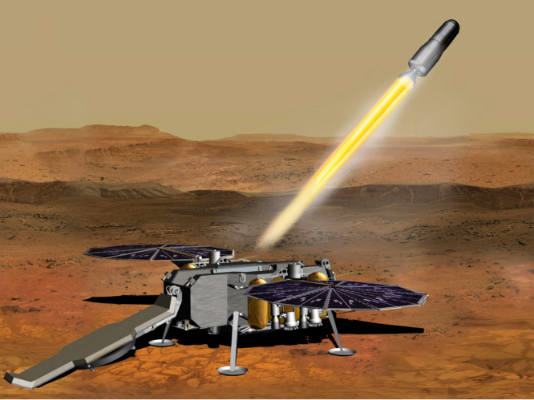 Image credit: NASA/JPL-Caltech | Full image and caption
Image credit: NASA/JPL-Caltech | Full image and caption
NASA and the European Space Agency (ESA) are solidifying concepts for a Mars Sample Return campaign after NASA’s Perseverance rover collects rock and sediment samples, storing them in sealed tubes to be left on the planet’s surface for future retrieval and return to Earth.
According to the current concept, NASA will deliver a lander with a NASA rocket (the Mars Ascent Vehicle) and ESA’s Sample Fetch Rover. The fetch rover will gather the cached samples and carry them to the lander for transfer to the ascent vehicle; samples could also be delivered by Perseverance.
ESA will put a spacecraft in orbit at Mars. The ascent vehicle will then launch a special container holding the samples into Mars orbit. The orbiter will rendezvous with and capture the orbiting samples in order to return them to Earth. NASA will provide the payload module for the orbiter, performing the capture and containment of the orbiting samples at Mars and landing the samples on Earth.




